SM0374 - Strategic Management & Leadership: Apple's Success Factors
VerifiedAdded on 2023/06/13
|21
|5273
|94
Report
AI Summary
This report provides a comprehensive analysis of Apple's success through the lens of strategic management and leadership. It defines success using indicators like balanced scorecards, gross profit, customer satisfaction, and employee satisfaction. The report identifies reasons for Apple's success, including continuous innovation, competitor awareness, focused product strategy, and clear market segmentation. An internal analysis, including value chain and VRIN framework, is conducted to assess Apple's core competencies. The contribution of leadership, particularly Tim Cook's influence on organizational culture, is examined. Furthermore, the report reviews Apple's growth, international, competitive, collaboration, and positioning strategies. It concludes with an analysis of future challenges using PEST factors and provides recommendations for sustaining Apple's success. Desklib offers a platform to explore similar solved assignments and study resources for students.
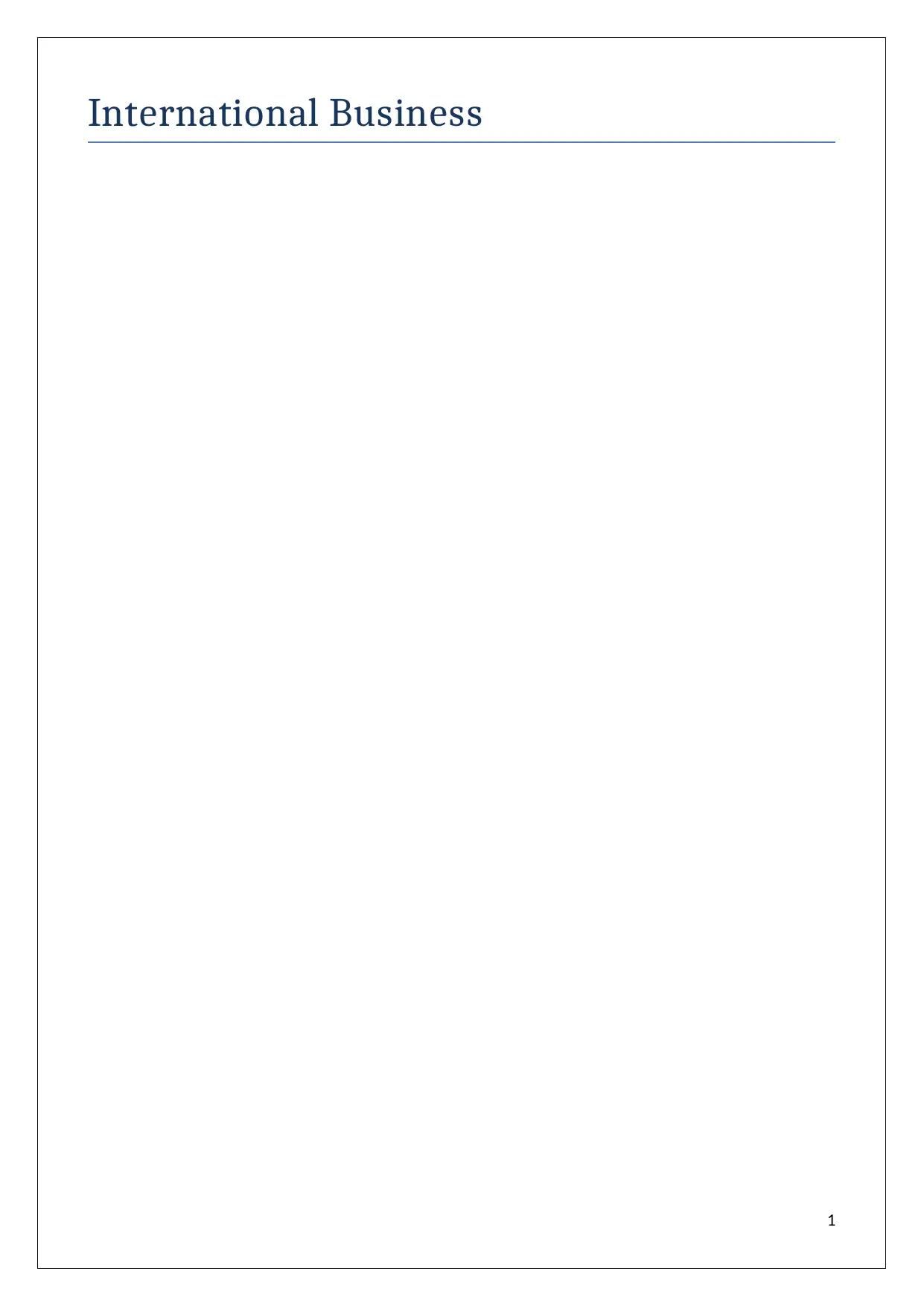
International Business
1
1
Paraphrase This Document
Need a fresh take? Get an instant paraphrase of this document with our AI Paraphraser
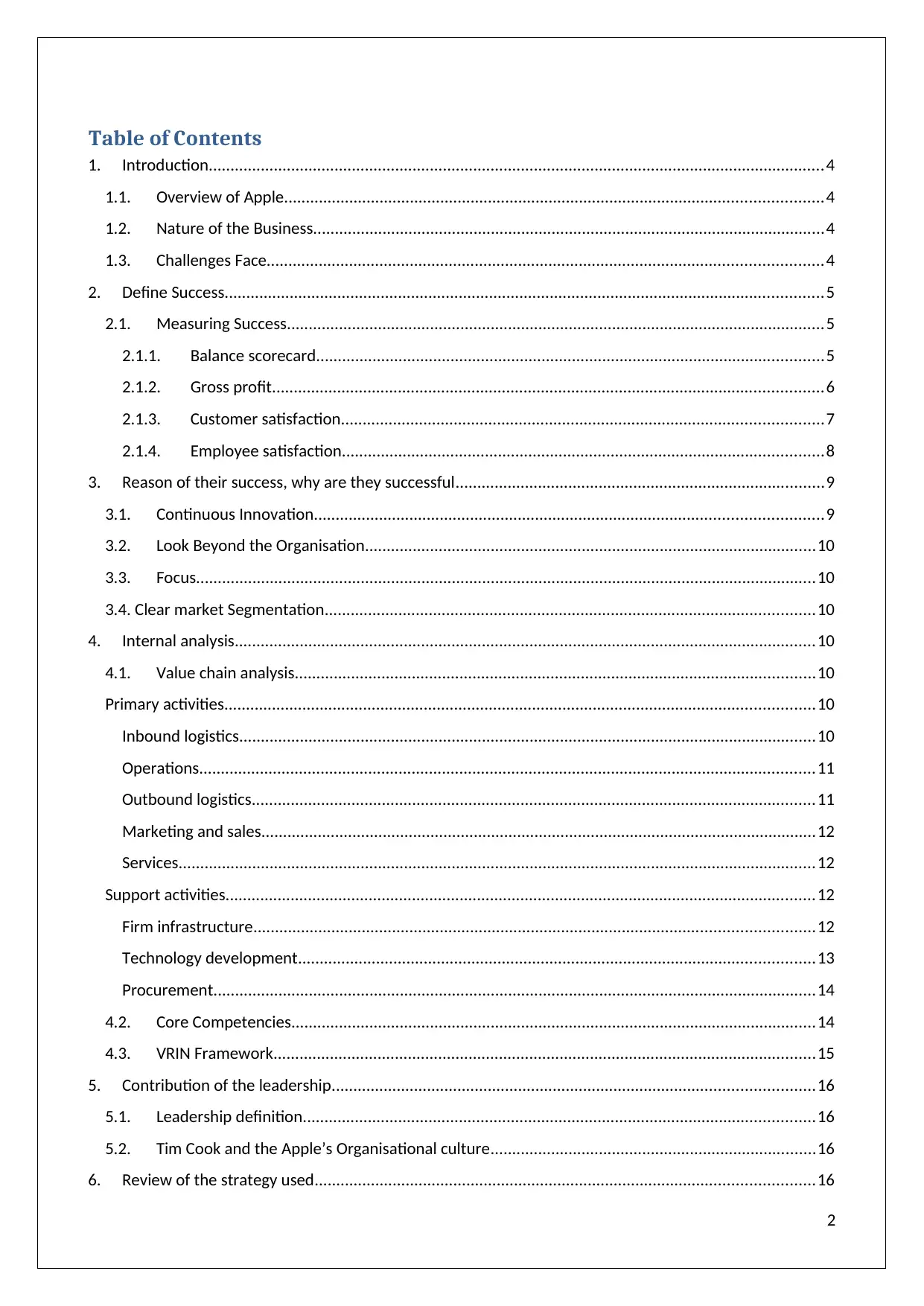
Table of Contents
1. Introduction..............................................................................................................................................4
1.1. Overview of Apple............................................................................................................................4
1.2. Nature of the Business......................................................................................................................4
1.3. Challenges Face................................................................................................................................4
2. Define Success..........................................................................................................................................5
2.1. Measuring Success............................................................................................................................5
2.1.1. Balance scorecard.....................................................................................................................5
2.1.2. Gross profit...............................................................................................................................6
2.1.3. Customer satisfaction...............................................................................................................7
2.1.4. Employee satisfaction...............................................................................................................8
3. Reason of their success, why are they successful.....................................................................................9
3.1. Continuous Innovation.....................................................................................................................9
3.2. Look Beyond the Organisation........................................................................................................10
3.3. Focus...............................................................................................................................................10
3.4. Clear market Segmentation.................................................................................................................10
4. Internal analysis......................................................................................................................................10
4.1. Value chain analysis........................................................................................................................10
Primary activities........................................................................................................................................10
Inbound logistics.....................................................................................................................................10
Operations..............................................................................................................................................11
Outbound logistics..................................................................................................................................11
Marketing and sales................................................................................................................................12
Services...................................................................................................................................................12
Support activities........................................................................................................................................12
Firm infrastructure.................................................................................................................................12
Technology development.......................................................................................................................13
Procurement...........................................................................................................................................14
4.2. Core Competencies.........................................................................................................................14
4.3. VRIN Framework.............................................................................................................................15
5. Contribution of the leadership...............................................................................................................16
5.1. Leadership definition......................................................................................................................16
5.2. Tim Cook and the Apple’s Organisational culture...........................................................................16
6. Review of the strategy used...................................................................................................................16
2
1. Introduction..............................................................................................................................................4
1.1. Overview of Apple............................................................................................................................4
1.2. Nature of the Business......................................................................................................................4
1.3. Challenges Face................................................................................................................................4
2. Define Success..........................................................................................................................................5
2.1. Measuring Success............................................................................................................................5
2.1.1. Balance scorecard.....................................................................................................................5
2.1.2. Gross profit...............................................................................................................................6
2.1.3. Customer satisfaction...............................................................................................................7
2.1.4. Employee satisfaction...............................................................................................................8
3. Reason of their success, why are they successful.....................................................................................9
3.1. Continuous Innovation.....................................................................................................................9
3.2. Look Beyond the Organisation........................................................................................................10
3.3. Focus...............................................................................................................................................10
3.4. Clear market Segmentation.................................................................................................................10
4. Internal analysis......................................................................................................................................10
4.1. Value chain analysis........................................................................................................................10
Primary activities........................................................................................................................................10
Inbound logistics.....................................................................................................................................10
Operations..............................................................................................................................................11
Outbound logistics..................................................................................................................................11
Marketing and sales................................................................................................................................12
Services...................................................................................................................................................12
Support activities........................................................................................................................................12
Firm infrastructure.................................................................................................................................12
Technology development.......................................................................................................................13
Procurement...........................................................................................................................................14
4.2. Core Competencies.........................................................................................................................14
4.3. VRIN Framework.............................................................................................................................15
5. Contribution of the leadership...............................................................................................................16
5.1. Leadership definition......................................................................................................................16
5.2. Tim Cook and the Apple’s Organisational culture...........................................................................16
6. Review of the strategy used...................................................................................................................16
2
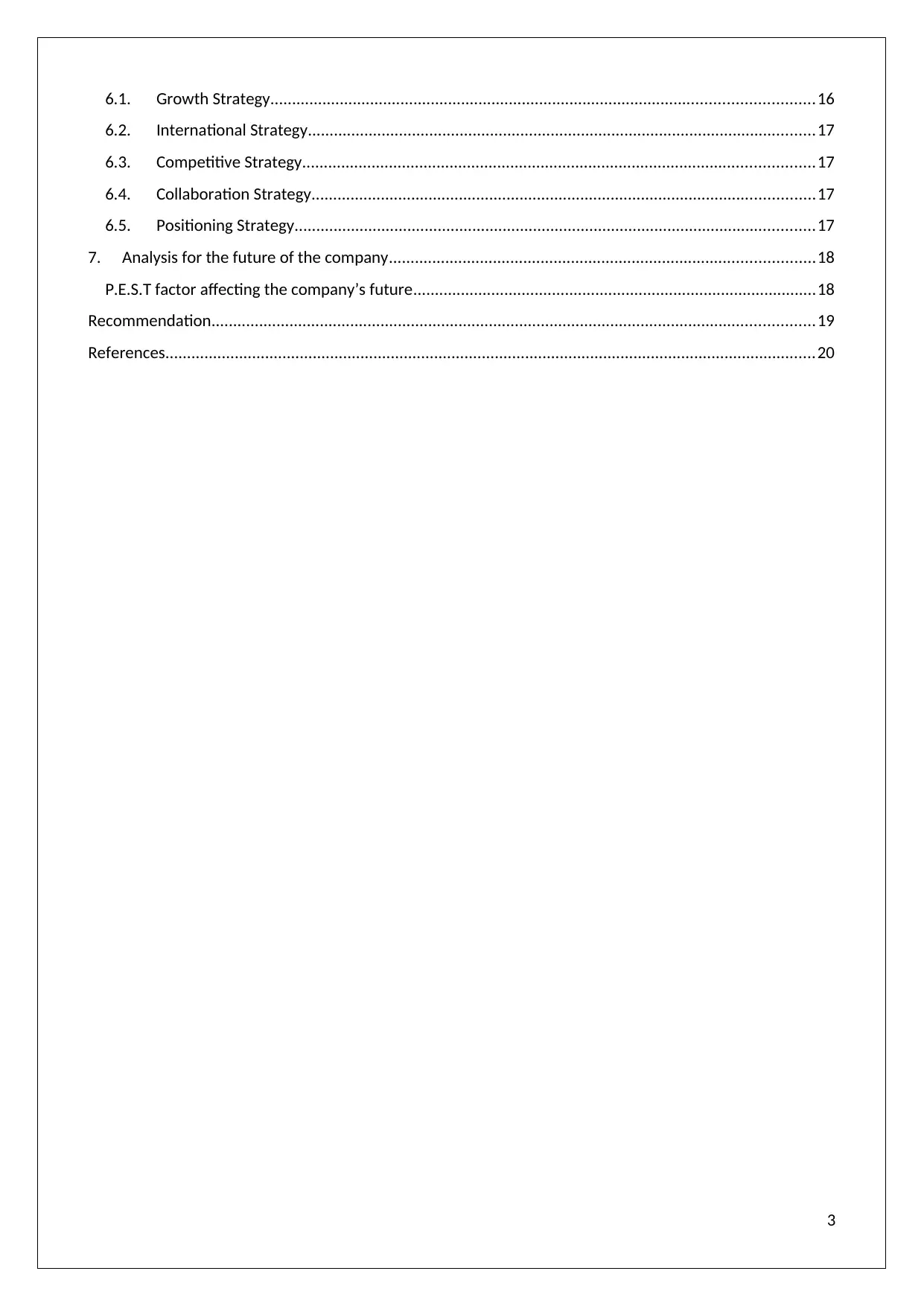
6.1. Growth Strategy.............................................................................................................................16
6.2. International Strategy.....................................................................................................................17
6.3. Competitive Strategy......................................................................................................................17
6.4. Collaboration Strategy....................................................................................................................17
6.5. Positioning Strategy........................................................................................................................17
7. Analysis for the future of the company..................................................................................................18
P.E.S.T factor affecting the company’s future.............................................................................................18
Recommendation...........................................................................................................................................19
References......................................................................................................................................................20
3
6.2. International Strategy.....................................................................................................................17
6.3. Competitive Strategy......................................................................................................................17
6.4. Collaboration Strategy....................................................................................................................17
6.5. Positioning Strategy........................................................................................................................17
7. Analysis for the future of the company..................................................................................................18
P.E.S.T factor affecting the company’s future.............................................................................................18
Recommendation...........................................................................................................................................19
References......................................................................................................................................................20
3
⊘ This is a preview!⊘
Do you want full access?
Subscribe today to unlock all pages.

Trusted by 1+ million students worldwide
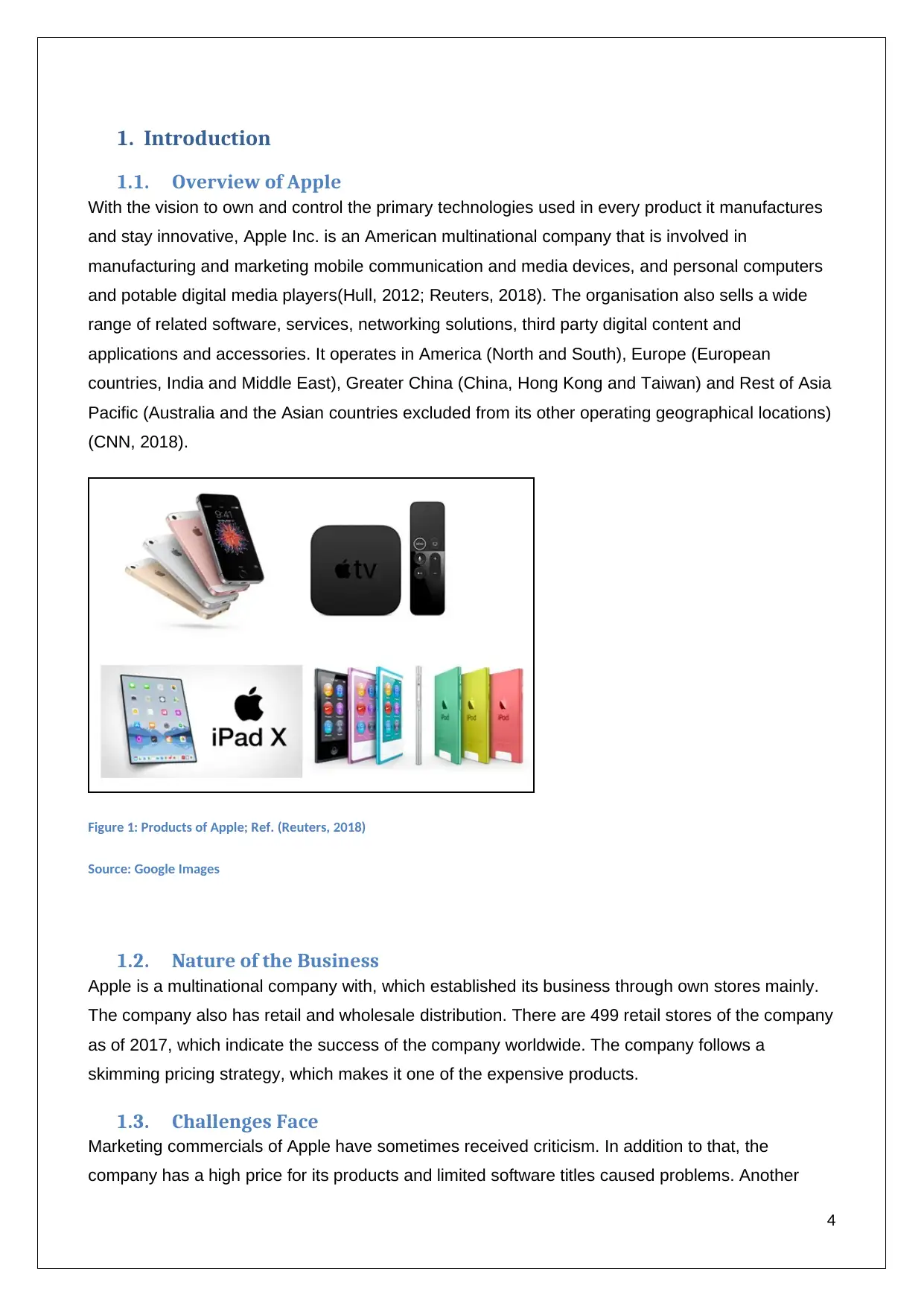
1. Introduction
1.1. Overview of Apple
With the vision to own and control the primary technologies used in every product it manufactures
and stay innovative, Apple Inc. is an American multinational company that is involved in
manufacturing and marketing mobile communication and media devices, and personal computers
and potable digital media players(Hull, 2012; Reuters, 2018). The organisation also sells a wide
range of related software, services, networking solutions, third party digital content and
applications and accessories. It operates in America (North and South), Europe (European
countries, India and Middle East), Greater China (China, Hong Kong and Taiwan) and Rest of Asia
Pacific (Australia and the Asian countries excluded from its other operating geographical locations)
(CNN, 2018).
Figure 1: Products of Apple; Ref. (Reuters, 2018)
Source: Google Images
1.2. Nature of the Business
Apple is a multinational company with, which established its business through own stores mainly.
The company also has retail and wholesale distribution. There are 499 retail stores of the company
as of 2017, which indicate the success of the company worldwide. The company follows a
skimming pricing strategy, which makes it one of the expensive products.
1.3. Challenges Face
Marketing commercials of Apple have sometimes received criticism. In addition to that, the
company has a high price for its products and limited software titles caused problems. Another
4
1.1. Overview of Apple
With the vision to own and control the primary technologies used in every product it manufactures
and stay innovative, Apple Inc. is an American multinational company that is involved in
manufacturing and marketing mobile communication and media devices, and personal computers
and potable digital media players(Hull, 2012; Reuters, 2018). The organisation also sells a wide
range of related software, services, networking solutions, third party digital content and
applications and accessories. It operates in America (North and South), Europe (European
countries, India and Middle East), Greater China (China, Hong Kong and Taiwan) and Rest of Asia
Pacific (Australia and the Asian countries excluded from its other operating geographical locations)
(CNN, 2018).
Figure 1: Products of Apple; Ref. (Reuters, 2018)
Source: Google Images
1.2. Nature of the Business
Apple is a multinational company with, which established its business through own stores mainly.
The company also has retail and wholesale distribution. There are 499 retail stores of the company
as of 2017, which indicate the success of the company worldwide. The company follows a
skimming pricing strategy, which makes it one of the expensive products.
1.3. Challenges Face
Marketing commercials of Apple have sometimes received criticism. In addition to that, the
company has a high price for its products and limited software titles caused problems. Another
4
Paraphrase This Document
Need a fresh take? Get an instant paraphrase of this document with our AI Paraphraser
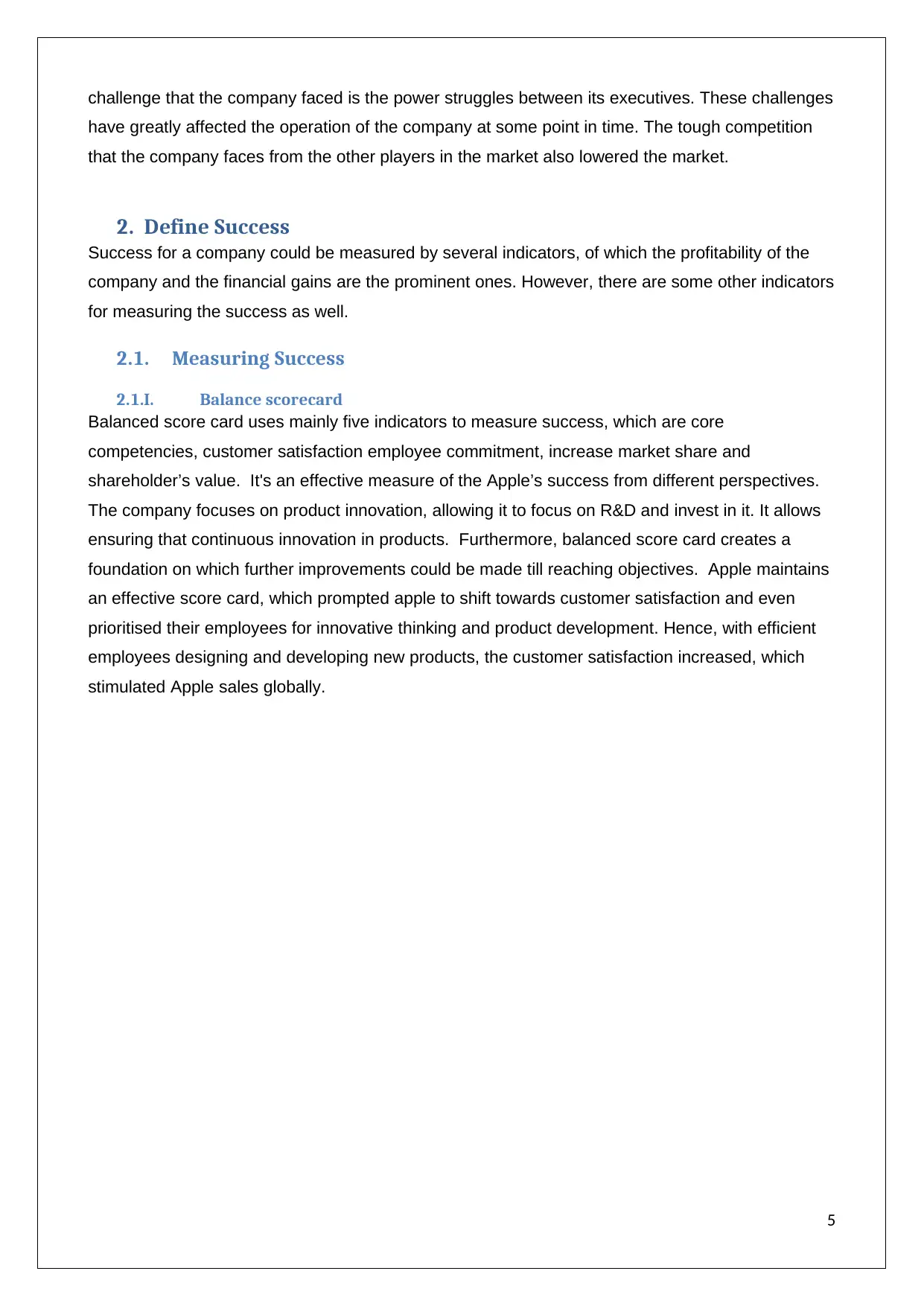
challenge that the company faced is the power struggles between its executives. These challenges
have greatly affected the operation of the company at some point in time. The tough competition
that the company faces from the other players in the market also lowered the market.
2. Define Success
Success for a company could be measured by several indicators, of which the profitability of the
company and the financial gains are the prominent ones. However, there are some other indicators
for measuring the success as well.
2.1. Measuring Success
2.1.I. Balance scorecard
Balanced score card uses mainly five indicators to measure success, which are core
competencies, customer satisfaction employee commitment, increase market share and
shareholder’s value. It's an effective measure of the Apple’s success from different perspectives.
The company focuses on product innovation, allowing it to focus on R&D and invest in it. It allows
ensuring that continuous innovation in products. Furthermore, balanced score card creates a
foundation on which further improvements could be made till reaching objectives. Apple maintains
an effective score card, which prompted apple to shift towards customer satisfaction and even
prioritised their employees for innovative thinking and product development. Hence, with efficient
employees designing and developing new products, the customer satisfaction increased, which
stimulated Apple sales globally.
5
have greatly affected the operation of the company at some point in time. The tough competition
that the company faces from the other players in the market also lowered the market.
2. Define Success
Success for a company could be measured by several indicators, of which the profitability of the
company and the financial gains are the prominent ones. However, there are some other indicators
for measuring the success as well.
2.1. Measuring Success
2.1.I. Balance scorecard
Balanced score card uses mainly five indicators to measure success, which are core
competencies, customer satisfaction employee commitment, increase market share and
shareholder’s value. It's an effective measure of the Apple’s success from different perspectives.
The company focuses on product innovation, allowing it to focus on R&D and invest in it. It allows
ensuring that continuous innovation in products. Furthermore, balanced score card creates a
foundation on which further improvements could be made till reaching objectives. Apple maintains
an effective score card, which prompted apple to shift towards customer satisfaction and even
prioritised their employees for innovative thinking and product development. Hence, with efficient
employees designing and developing new products, the customer satisfaction increased, which
stimulated Apple sales globally.
5
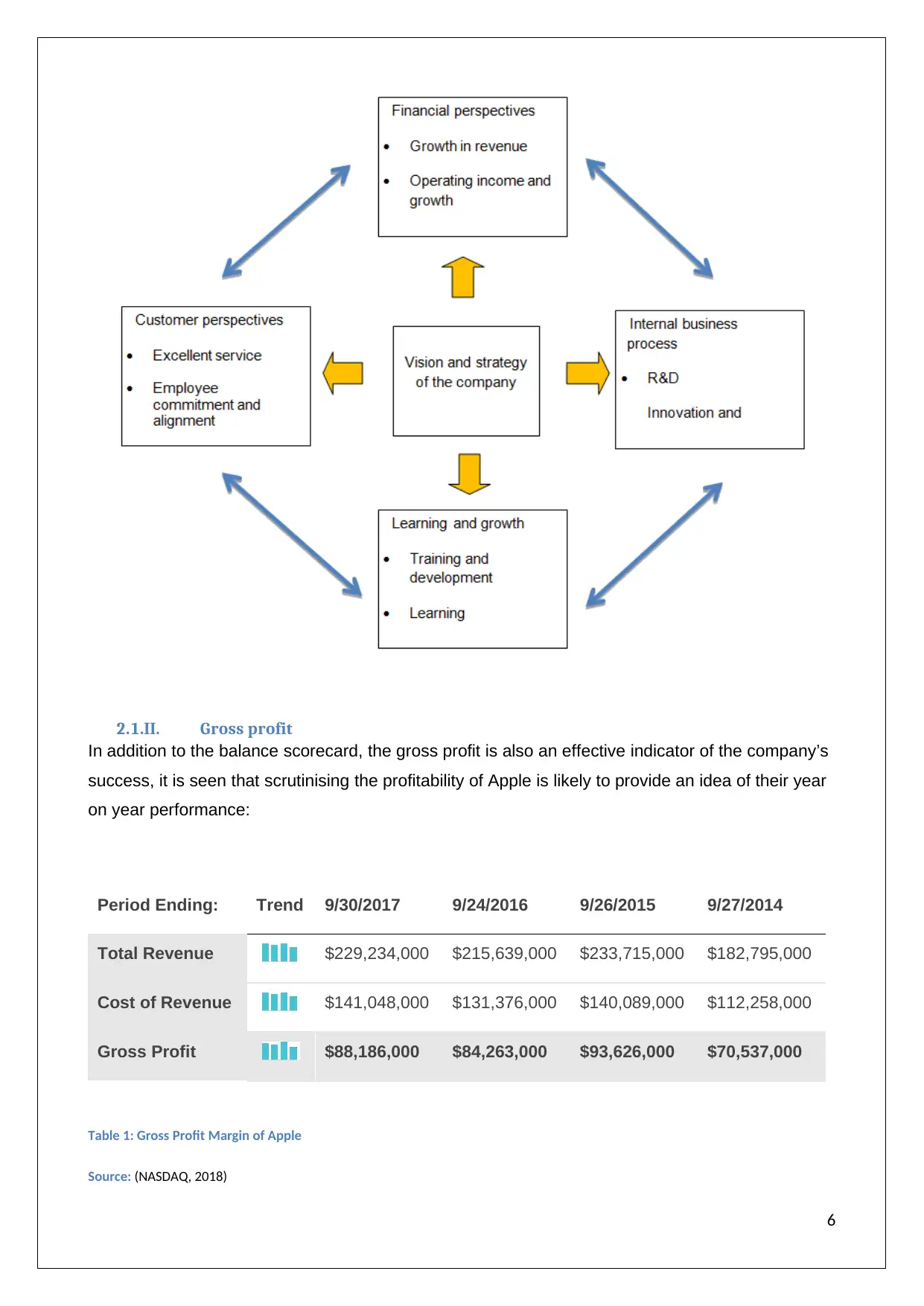
2.1.II. Gross profit
In addition to the balance scorecard, the gross profit is also an effective indicator of the company’s
success, it is seen that scrutinising the profitability of Apple is likely to provide an idea of their year
on year performance:
Period Ending: Trend 9/30/2017 9/24/2016 9/26/2015 9/27/2014
Total Revenue $229,234,000 $215,639,000 $233,715,000 $182,795,000
Cost of Revenue $141,048,000 $131,376,000 $140,089,000 $112,258,000
Gross Profit $88,186,000 $84,263,000 $93,626,000 $70,537,000
Table 1: Gross Profit Margin of Apple
Source: (NASDAQ, 2018)
6
In addition to the balance scorecard, the gross profit is also an effective indicator of the company’s
success, it is seen that scrutinising the profitability of Apple is likely to provide an idea of their year
on year performance:
Period Ending: Trend 9/30/2017 9/24/2016 9/26/2015 9/27/2014
Total Revenue $229,234,000 $215,639,000 $233,715,000 $182,795,000
Cost of Revenue $141,048,000 $131,376,000 $140,089,000 $112,258,000
Gross Profit $88,186,000 $84,263,000 $93,626,000 $70,537,000
Table 1: Gross Profit Margin of Apple
Source: (NASDAQ, 2018)
6
⊘ This is a preview!⊘
Do you want full access?
Subscribe today to unlock all pages.

Trusted by 1+ million students worldwide
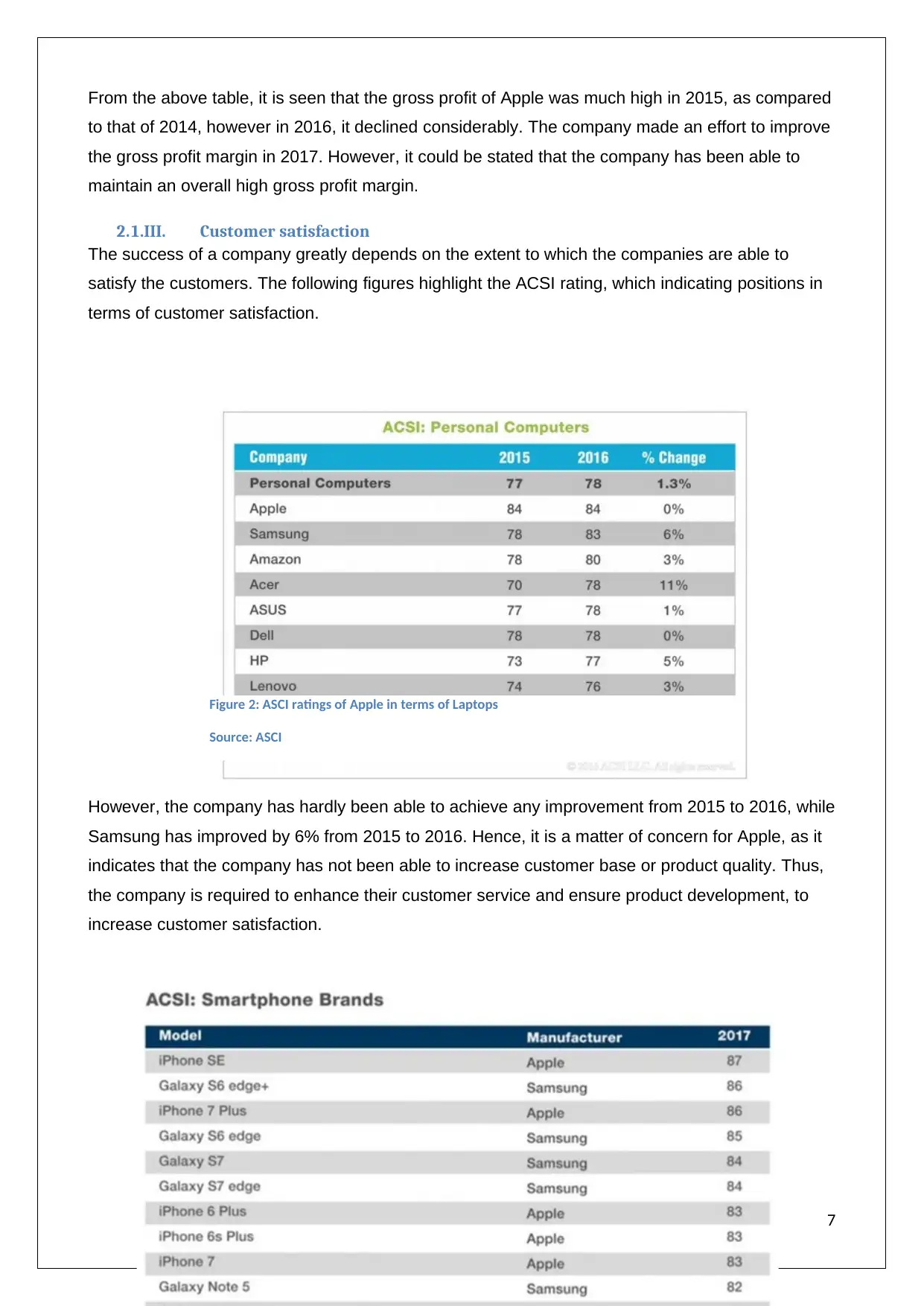
From the above table, it is seen that the gross profit of Apple was much high in 2015, as compared
to that of 2014, however in 2016, it declined considerably. The company made an effort to improve
the gross profit margin in 2017. However, it could be stated that the company has been able to
maintain an overall high gross profit margin.
2.1.III. Customer satisfaction
The success of a company greatly depends on the extent to which the companies are able to
satisfy the customers. The following figures highlight the ACSI rating, which indicating positions in
terms of customer satisfaction.
However, the company has hardly been able to achieve any improvement from 2015 to 2016, while
Samsung has improved by 6% from 2015 to 2016. Hence, it is a matter of concern for Apple, as it
indicates that the company has not been able to increase customer base or product quality. Thus,
the company is required to enhance their customer service and ensure product development, to
increase customer satisfaction.
7
Figure 2: ASCI ratings of Apple in terms of Laptops
Source: ASCI
to that of 2014, however in 2016, it declined considerably. The company made an effort to improve
the gross profit margin in 2017. However, it could be stated that the company has been able to
maintain an overall high gross profit margin.
2.1.III. Customer satisfaction
The success of a company greatly depends on the extent to which the companies are able to
satisfy the customers. The following figures highlight the ACSI rating, which indicating positions in
terms of customer satisfaction.
However, the company has hardly been able to achieve any improvement from 2015 to 2016, while
Samsung has improved by 6% from 2015 to 2016. Hence, it is a matter of concern for Apple, as it
indicates that the company has not been able to increase customer base or product quality. Thus,
the company is required to enhance their customer service and ensure product development, to
increase customer satisfaction.
7
Figure 2: ASCI ratings of Apple in terms of Laptops
Source: ASCI
Paraphrase This Document
Need a fresh take? Get an instant paraphrase of this document with our AI Paraphraser
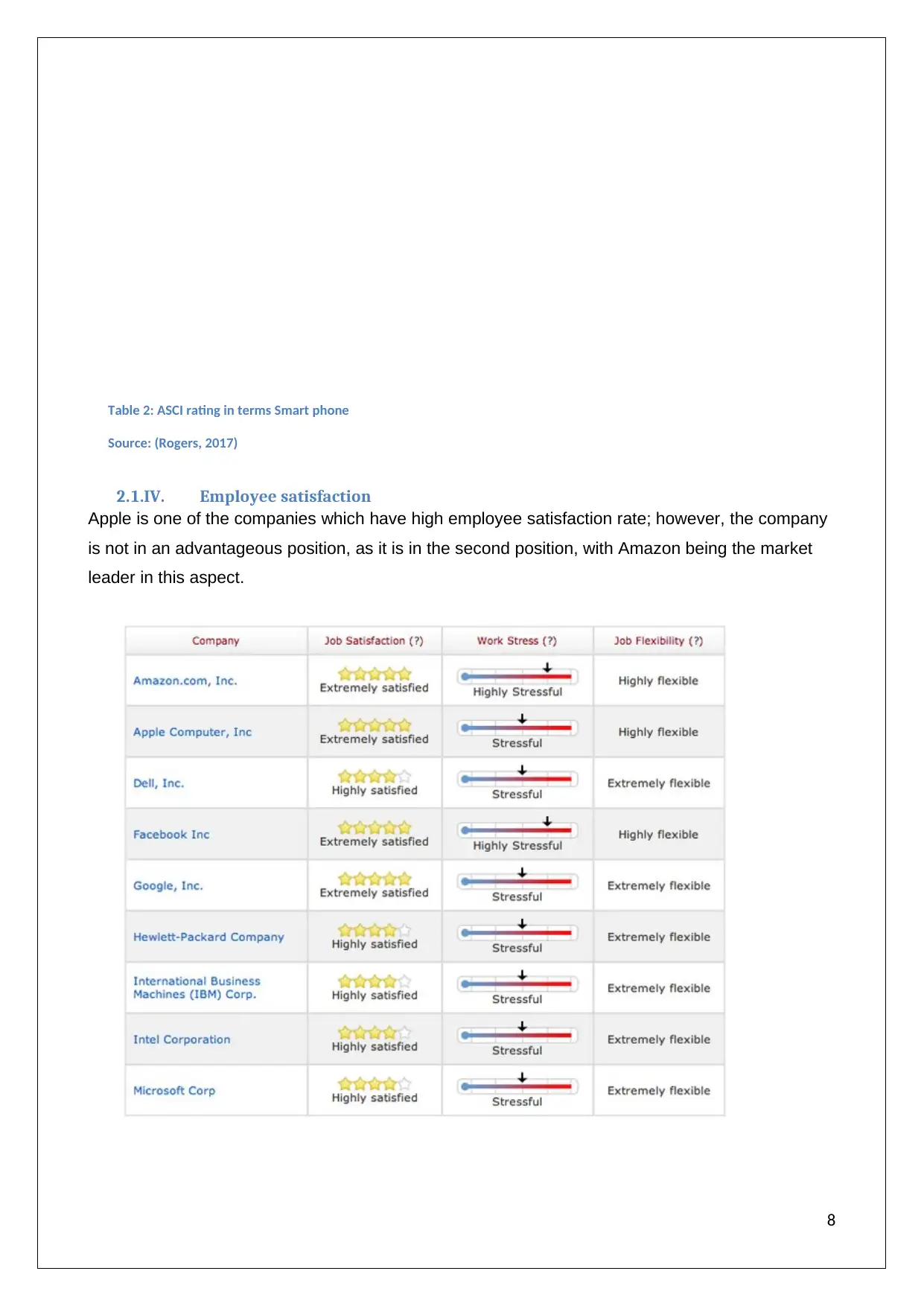
2.1.IV. Employee satisfaction
Apple is one of the companies which have high employee satisfaction rate; however, the company
is not in an advantageous position, as it is in the second position, with Amazon being the market
leader in this aspect.
8
Table 2: ASCI rating in terms Smart phone
Source: (Rogers, 2017)
Apple is one of the companies which have high employee satisfaction rate; however, the company
is not in an advantageous position, as it is in the second position, with Amazon being the market
leader in this aspect.
8
Table 2: ASCI rating in terms Smart phone
Source: (Rogers, 2017)
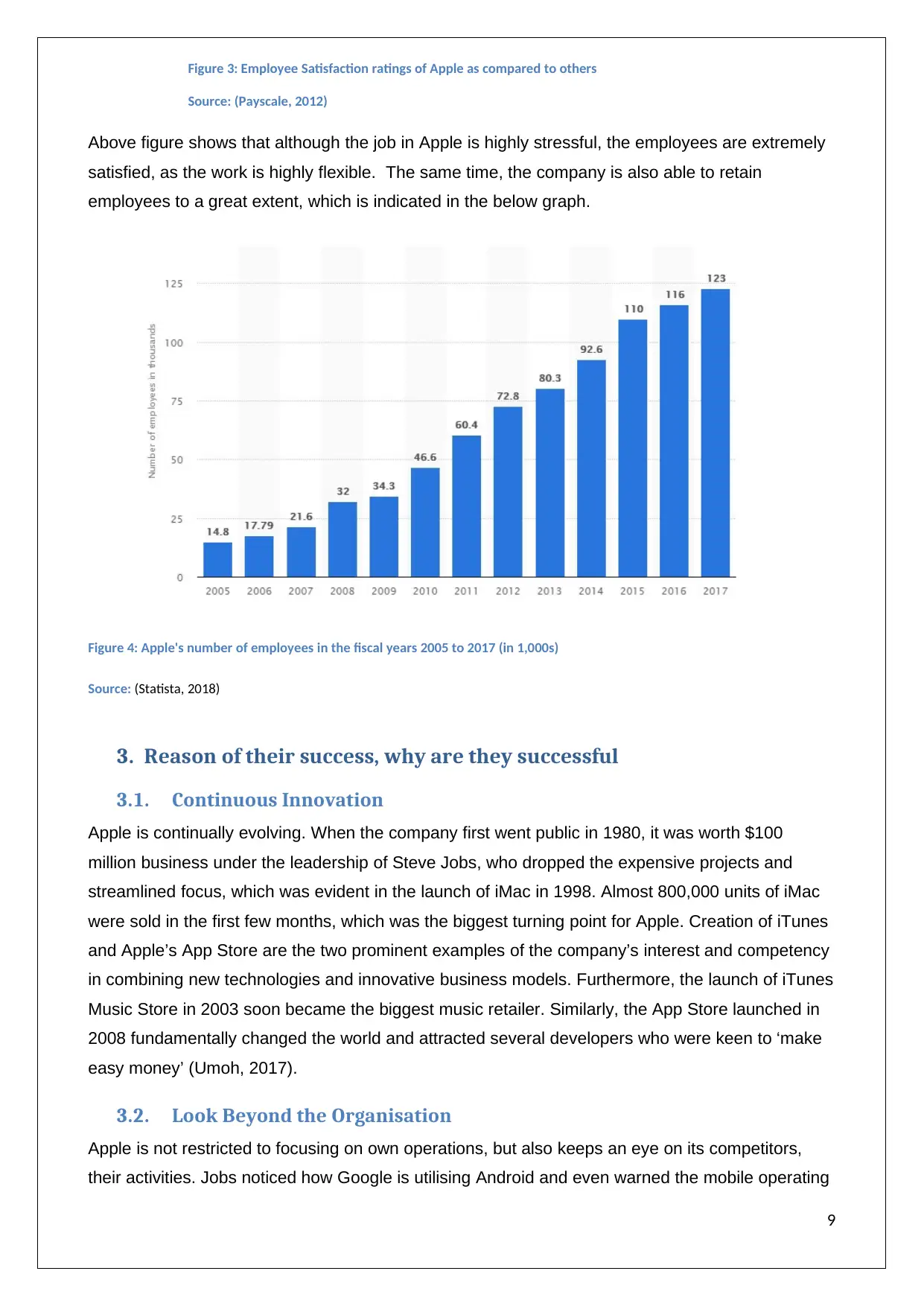
Above figure shows that although the job in Apple is highly stressful, the employees are extremely
satisfied, as the work is highly flexible. The same time, the company is also able to retain
employees to a great extent, which is indicated in the below graph.
Figure 4: Apple's number of employees in the fiscal years 2005 to 2017 (in 1,000s)
Source: (Statista, 2018)
3. Reason of their success, why are they successful
3.1. Continuous Innovation
Apple is continually evolving. When the company first went public in 1980, it was worth $100
million business under the leadership of Steve Jobs, who dropped the expensive projects and
streamlined focus, which was evident in the launch of iMac in 1998. Almost 800,000 units of iMac
were sold in the first few months, which was the biggest turning point for Apple. Creation of iTunes
and Apple’s App Store are the two prominent examples of the company’s interest and competency
in combining new technologies and innovative business models. Furthermore, the launch of iTunes
Music Store in 2003 soon became the biggest music retailer. Similarly, the App Store launched in
2008 fundamentally changed the world and attracted several developers who were keen to ‘make
easy money’ (Umoh, 2017).
3.2. Look Beyond the Organisation
Apple is not restricted to focusing on own operations, but also keeps an eye on its competitors,
their activities. Jobs noticed how Google is utilising Android and even warned the mobile operating
9
Figure 3: Employee Satisfaction ratings of Apple as compared to others
Source: (Payscale, 2012)
satisfied, as the work is highly flexible. The same time, the company is also able to retain
employees to a great extent, which is indicated in the below graph.
Figure 4: Apple's number of employees in the fiscal years 2005 to 2017 (in 1,000s)
Source: (Statista, 2018)
3. Reason of their success, why are they successful
3.1. Continuous Innovation
Apple is continually evolving. When the company first went public in 1980, it was worth $100
million business under the leadership of Steve Jobs, who dropped the expensive projects and
streamlined focus, which was evident in the launch of iMac in 1998. Almost 800,000 units of iMac
were sold in the first few months, which was the biggest turning point for Apple. Creation of iTunes
and Apple’s App Store are the two prominent examples of the company’s interest and competency
in combining new technologies and innovative business models. Furthermore, the launch of iTunes
Music Store in 2003 soon became the biggest music retailer. Similarly, the App Store launched in
2008 fundamentally changed the world and attracted several developers who were keen to ‘make
easy money’ (Umoh, 2017).
3.2. Look Beyond the Organisation
Apple is not restricted to focusing on own operations, but also keeps an eye on its competitors,
their activities. Jobs noticed how Google is utilising Android and even warned the mobile operating
9
Figure 3: Employee Satisfaction ratings of Apple as compared to others
Source: (Payscale, 2012)
⊘ This is a preview!⊘
Do you want full access?
Subscribe today to unlock all pages.

Trusted by 1+ million students worldwide
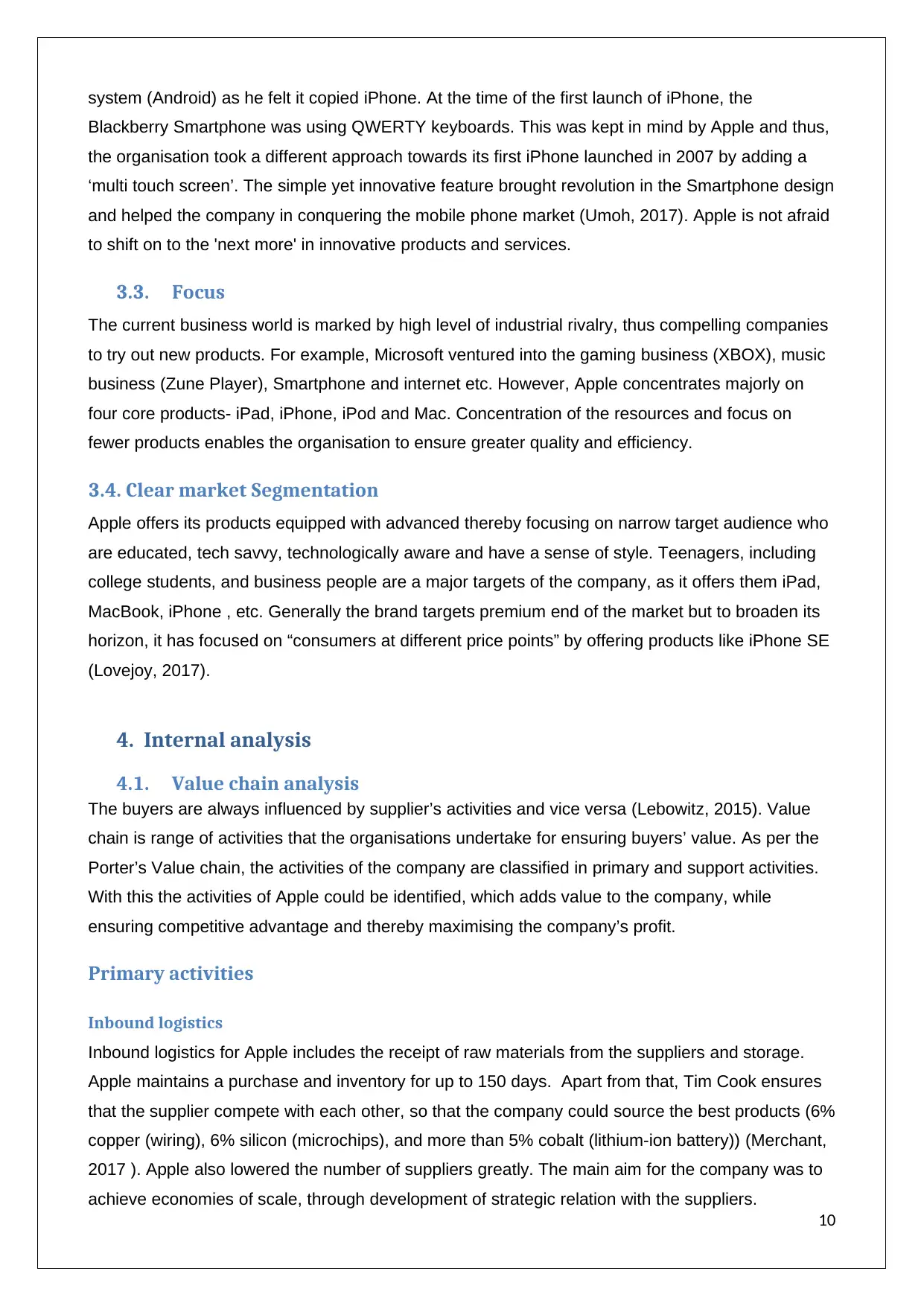
system (Android) as he felt it copied iPhone. At the time of the first launch of iPhone, the
Blackberry Smartphone was using QWERTY keyboards. This was kept in mind by Apple and thus,
the organisation took a different approach towards its first iPhone launched in 2007 by adding a
‘multi touch screen’. The simple yet innovative feature brought revolution in the Smartphone design
and helped the company in conquering the mobile phone market (Umoh, 2017). Apple is not afraid
to shift on to the 'next more' in innovative products and services.
3.3. Focus
The current business world is marked by high level of industrial rivalry, thus compelling companies
to try out new products. For example, Microsoft ventured into the gaming business (XBOX), music
business (Zune Player), Smartphone and internet etc. However, Apple concentrates majorly on
four core products- iPad, iPhone, iPod and Mac. Concentration of the resources and focus on
fewer products enables the organisation to ensure greater quality and efficiency.
3.4. Clear market Segmentation
Apple offers its products equipped with advanced thereby focusing on narrow target audience who
are educated, tech savvy, technologically aware and have a sense of style. Teenagers, including
college students, and business people are a major targets of the company, as it offers them iPad,
MacBook, iPhone , etc. Generally the brand targets premium end of the market but to broaden its
horizon, it has focused on “consumers at different price points” by offering products like iPhone SE
(Lovejoy, 2017).
4. Internal analysis
4.1. Value chain analysis
The buyers are always influenced by supplier’s activities and vice versa (Lebowitz, 2015). Value
chain is range of activities that the organisations undertake for ensuring buyers’ value. As per the
Porter’s Value chain, the activities of the company are classified in primary and support activities.
With this the activities of Apple could be identified, which adds value to the company, while
ensuring competitive advantage and thereby maximising the company’s profit.
Primary activities
Inbound logistics
Inbound logistics for Apple includes the receipt of raw materials from the suppliers and storage.
Apple maintains a purchase and inventory for up to 150 days. Apart from that, Tim Cook ensures
that the supplier compete with each other, so that the company could source the best products (6%
copper (wiring), 6% silicon (microchips), and more than 5% cobalt (lithium-ion battery)) (Merchant,
2017 ). Apple also lowered the number of suppliers greatly. The main aim for the company was to
achieve economies of scale, through development of strategic relation with the suppliers.
10
Blackberry Smartphone was using QWERTY keyboards. This was kept in mind by Apple and thus,
the organisation took a different approach towards its first iPhone launched in 2007 by adding a
‘multi touch screen’. The simple yet innovative feature brought revolution in the Smartphone design
and helped the company in conquering the mobile phone market (Umoh, 2017). Apple is not afraid
to shift on to the 'next more' in innovative products and services.
3.3. Focus
The current business world is marked by high level of industrial rivalry, thus compelling companies
to try out new products. For example, Microsoft ventured into the gaming business (XBOX), music
business (Zune Player), Smartphone and internet etc. However, Apple concentrates majorly on
four core products- iPad, iPhone, iPod and Mac. Concentration of the resources and focus on
fewer products enables the organisation to ensure greater quality and efficiency.
3.4. Clear market Segmentation
Apple offers its products equipped with advanced thereby focusing on narrow target audience who
are educated, tech savvy, technologically aware and have a sense of style. Teenagers, including
college students, and business people are a major targets of the company, as it offers them iPad,
MacBook, iPhone , etc. Generally the brand targets premium end of the market but to broaden its
horizon, it has focused on “consumers at different price points” by offering products like iPhone SE
(Lovejoy, 2017).
4. Internal analysis
4.1. Value chain analysis
The buyers are always influenced by supplier’s activities and vice versa (Lebowitz, 2015). Value
chain is range of activities that the organisations undertake for ensuring buyers’ value. As per the
Porter’s Value chain, the activities of the company are classified in primary and support activities.
With this the activities of Apple could be identified, which adds value to the company, while
ensuring competitive advantage and thereby maximising the company’s profit.
Primary activities
Inbound logistics
Inbound logistics for Apple includes the receipt of raw materials from the suppliers and storage.
Apple maintains a purchase and inventory for up to 150 days. Apart from that, Tim Cook ensures
that the supplier compete with each other, so that the company could source the best products (6%
copper (wiring), 6% silicon (microchips), and more than 5% cobalt (lithium-ion battery)) (Merchant,
2017 ). Apple also lowered the number of suppliers greatly. The main aim for the company was to
achieve economies of scale, through development of strategic relation with the suppliers.
10
Paraphrase This Document
Need a fresh take? Get an instant paraphrase of this document with our AI Paraphraser
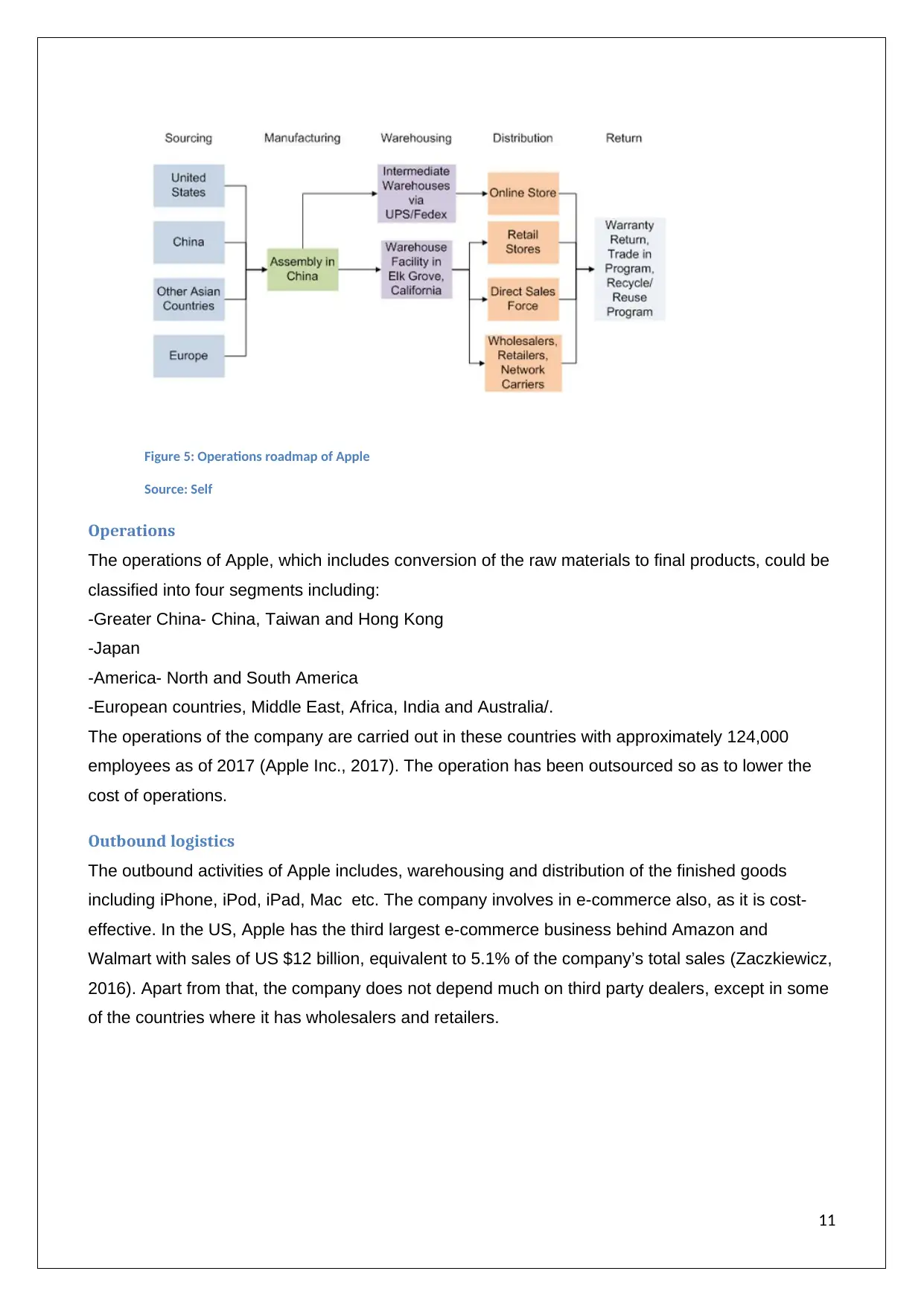
Operations
The operations of Apple, which includes conversion of the raw materials to final products, could be
classified into four segments including:
-Greater China- China, Taiwan and Hong Kong
-Japan
-America- North and South America
-European countries, Middle East, Africa, India and Australia/.
The operations of the company are carried out in these countries with approximately 124,000
employees as of 2017 (Apple Inc., 2017). The operation has been outsourced so as to lower the
cost of operations.
Outbound logistics
The outbound activities of Apple includes, warehousing and distribution of the finished goods
including iPhone, iPod, iPad, Mac etc. The company involves in e-commerce also, as it is cost-
effective. In the US, Apple has the third largest e-commerce business behind Amazon and
Walmart with sales of US $12 billion, equivalent to 5.1% of the company’s total sales (Zaczkiewicz,
2016). Apart from that, the company does not depend much on third party dealers, except in some
of the countries where it has wholesalers and retailers.
11
Figure 5: Operations roadmap of Apple
Source: Self
The operations of Apple, which includes conversion of the raw materials to final products, could be
classified into four segments including:
-Greater China- China, Taiwan and Hong Kong
-Japan
-America- North and South America
-European countries, Middle East, Africa, India and Australia/.
The operations of the company are carried out in these countries with approximately 124,000
employees as of 2017 (Apple Inc., 2017). The operation has been outsourced so as to lower the
cost of operations.
Outbound logistics
The outbound activities of Apple includes, warehousing and distribution of the finished goods
including iPhone, iPod, iPad, Mac etc. The company involves in e-commerce also, as it is cost-
effective. In the US, Apple has the third largest e-commerce business behind Amazon and
Walmart with sales of US $12 billion, equivalent to 5.1% of the company’s total sales (Zaczkiewicz,
2016). Apart from that, the company does not depend much on third party dealers, except in some
of the countries where it has wholesalers and retailers.
11
Figure 5: Operations roadmap of Apple
Source: Self
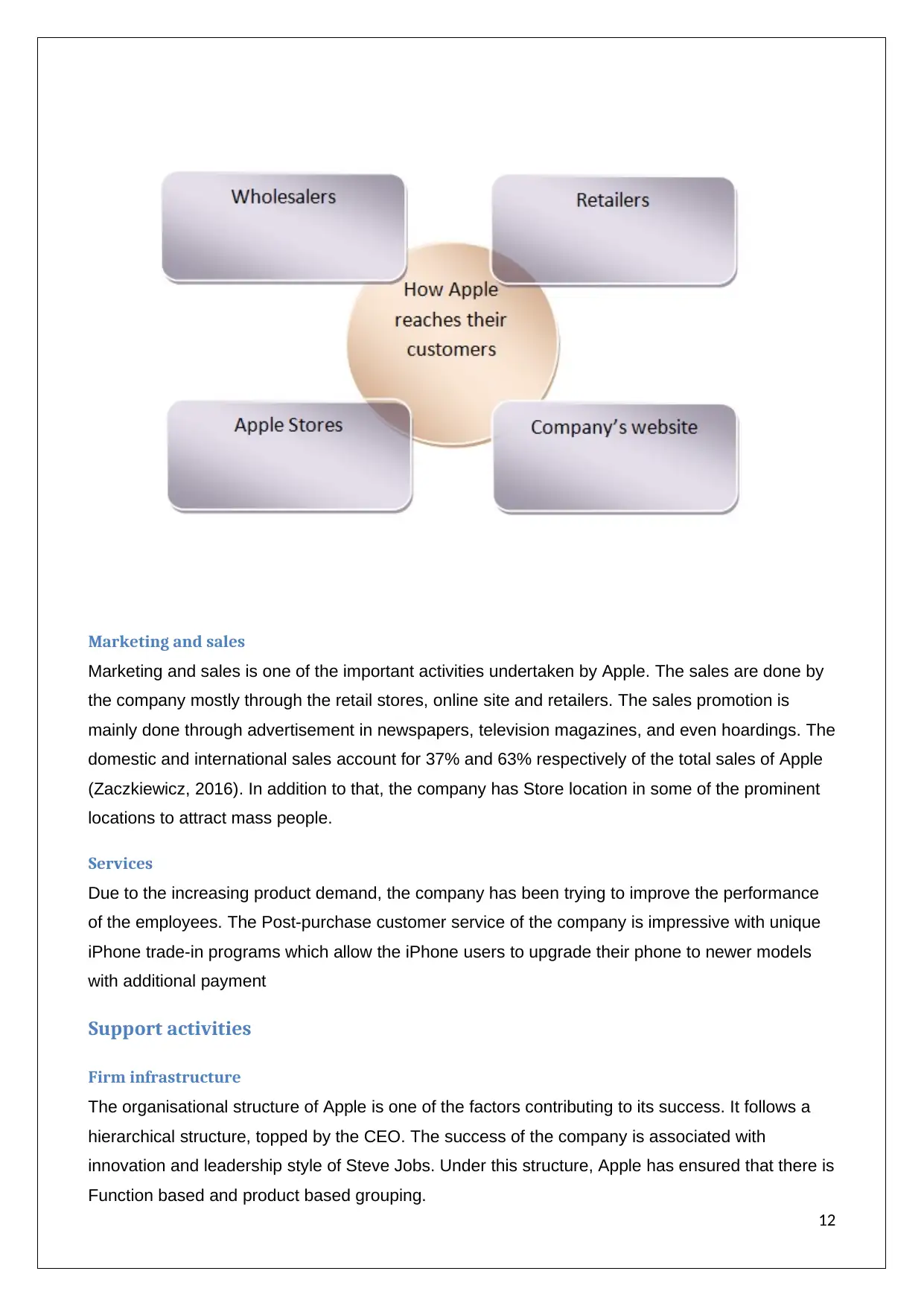
Marketing and sales
Marketing and sales is one of the important activities undertaken by Apple. The sales are done by
the company mostly through the retail stores, online site and retailers. The sales promotion is
mainly done through advertisement in newspapers, television magazines, and even hoardings. The
domestic and international sales account for 37% and 63% respectively of the total sales of Apple
(Zaczkiewicz, 2016). In addition to that, the company has Store location in some of the prominent
locations to attract mass people.
Services
Due to the increasing product demand, the company has been trying to improve the performance
of the employees. The Post-purchase customer service of the company is impressive with unique
iPhone trade-in programs which allow the iPhone users to upgrade their phone to newer models
with additional payment
Support activities
Firm infrastructure
The organisational structure of Apple is one of the factors contributing to its success. It follows a
hierarchical structure, topped by the CEO. The success of the company is associated with
innovation and leadership style of Steve Jobs. Under this structure, Apple has ensured that there is
Function based and product based grouping.
12
Marketing and sales is one of the important activities undertaken by Apple. The sales are done by
the company mostly through the retail stores, online site and retailers. The sales promotion is
mainly done through advertisement in newspapers, television magazines, and even hoardings. The
domestic and international sales account for 37% and 63% respectively of the total sales of Apple
(Zaczkiewicz, 2016). In addition to that, the company has Store location in some of the prominent
locations to attract mass people.
Services
Due to the increasing product demand, the company has been trying to improve the performance
of the employees. The Post-purchase customer service of the company is impressive with unique
iPhone trade-in programs which allow the iPhone users to upgrade their phone to newer models
with additional payment
Support activities
Firm infrastructure
The organisational structure of Apple is one of the factors contributing to its success. It follows a
hierarchical structure, topped by the CEO. The success of the company is associated with
innovation and leadership style of Steve Jobs. Under this structure, Apple has ensured that there is
Function based and product based grouping.
12
⊘ This is a preview!⊘
Do you want full access?
Subscribe today to unlock all pages.

Trusted by 1+ million students worldwide
1 out of 21
Related Documents
Your All-in-One AI-Powered Toolkit for Academic Success.
+13062052269
info@desklib.com
Available 24*7 on WhatsApp / Email
![[object Object]](/_next/static/media/star-bottom.7253800d.svg)
Unlock your academic potential
Copyright © 2020–2025 A2Z Services. All Rights Reserved. Developed and managed by ZUCOL.




